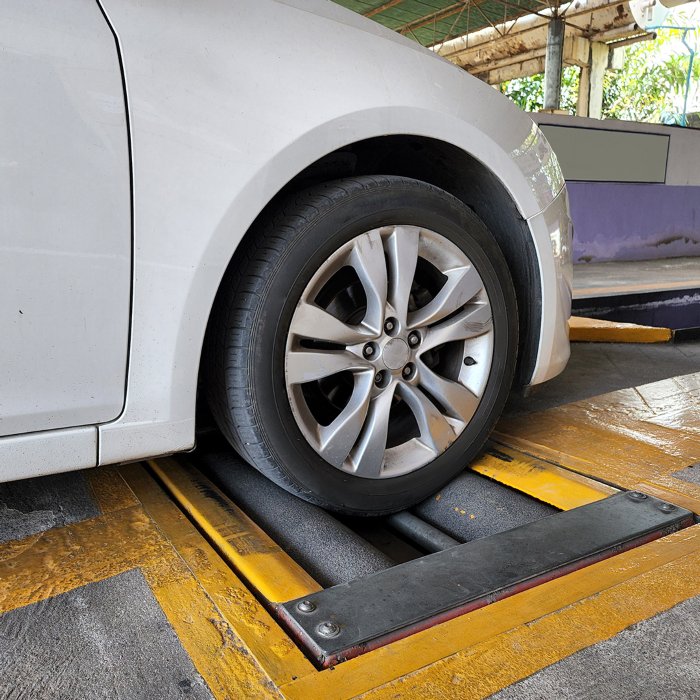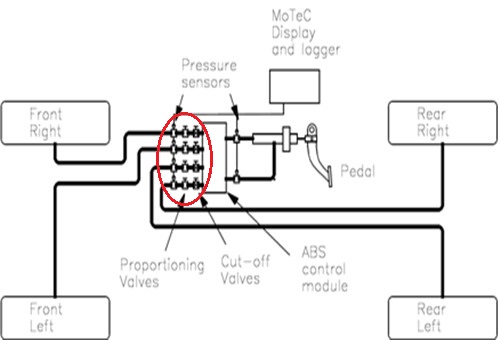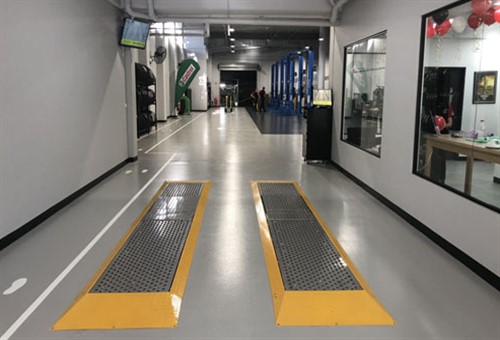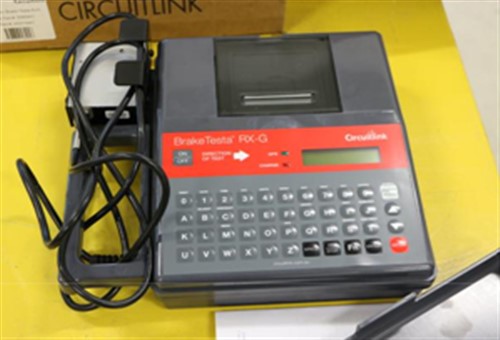
We’d all like to think that we give our customers the best possible service when we service, inspect, or repair their cars, but do we really? Think about it; we go through their vehicles with a proverbial fine-tooth comb during safety inspections and sometimes we find and fix issues other workshops had missed, or the vehicle owner did not realise existed. After the inspection, we even road test their vehicles to check for possible handling, steering, and/or vibration issues and we even test their brakes during the test drive. Then, we hand their vehicles back to them, issue a clean bill of health, and our customers leave mightily impressed with the excellent service they had received.
However, can we always be 100 per cent sure that we did not miss something? Did we miss something, like for instance, a potentially dangerous brake system performance issue that we did not detect because the vehicle stopped in a straight line and in a reasonable distance when we tested the brakes during a test drive?
Heaven forbid that we should have missed obvious faults like seized callipers, excessively worn rotors and/or brake pads, leaking wheel cylinders, or worse, severely contaminated, and/or degraded brake fluid. We have all seen conditions like this and while none of us would dream of ignoring them, the fact is that some of these issues (and many others) cannot be detected either by a visual brake inspection or by a dynamic brake test from say 80 km/h.
Fortunately, though, many brake system faults can be detected by various types of brake testing machines, and in this article, we will discuss the pros and cons of the three main types of brake testers in use in Australia today by drawing on the findings of a 2020 study performed by the University of Adelaide.
Before we get to the specifics though, we have to put the brake inspections we do on light vehicles into some kind of context relative to the regulatory requirements (of brake systems on light vehicles) that are now in force in Australia, so let us start with-
The requirements that brake systems on light motor vehicles have to comply with are many and varied, and these are laid out in Australian Design Rule 31/03 in excruciating detail, many of which date back to the late 1960s and early 1970s, when Australia adopted the regulations that were being developed in the US and European automotive markets.
Of course, ADR 31 has seen much revision and adaptation over the intervening decades to accommodate new technologies like ABS, Traction Control, Stability Control, Electronic Brake Distribution, and even regenerative braking systems on hybrid and electric vehicles. We need not delve into the complexities of these revisions here, beyond saying that while the testing methods prescribed by ADR 31/03 have evolved somewhat to keep pace with international standards, the actual performance requirements of brake systems on modern light vehicles have not. Consider the table below-

Image source: http://casr.adelaide.edu.au/publications/list/?id=1915
The figures presented here are both instructive and authoritative. They are instructive because they reflect performance standards that date from the late 1960s, and do not take into account the fact that many safety systems on modern vehicles depend on the vehicle’s brake system to be fully functional to operate a designed. In practice, the figures listed above translate into the fact that a modern light vehicle's brake system can be 40 per cent dysfunctional and still pass a regulatory brake test in any Australian jurisdiction.
The above figures are also authoritative because they were used as baseline data in a study performed in 2020 by the Centre For Automotive Safety research unit of the University of Adelaide* in conjunction with SafeTstop, a leading Australian manufacturer and vendor of brake testing equipment.
* Note while this study is available at no charge, accessing the test report requires a lengthy download from a provided link. Nonetheless, we strongly recommend that you download and study this report because it provides surprising insights into how many brake faults we as mechanics (sometimes) fail to detect during brake inspections and tests, simply because some defects and/or faults cannot be detected by simple inspections and road tests.
Limited space precludes even a cursory discussion on the factors that motivated this study, but having said that, it is important to point out that according to the authors of the study, this study was the first of its kind to be performed in Australia in about 30 years. Therefore, to save space, we will only mention the equipment the researchers used, and briefly describe the vehicle that was tested on all the equipment under repeatable conditions. We will discuss the testing equipment in turns, but let us look at-

Image source: http://casr.adelaide.edu.au/publications/list/?id=1915
This diagram shows the layout of the brake system on the test vehicle, with the adjustable brake proportioning valves that allowed researchers to induce brake faults circled in red.
The test vehicle was a 2011 Kia Cerato SLi hatchback that was supplied by SafeTstop. This vehicle was considered to be representative of the average passenger vehicle in Australia, and it was fitted with standard wheels and tyres in good condition, an automatic transmission, ABS on disc brakes on all four wheels, electronic stability control, traction control, and emergency brake assist. The handbrake was cable operated and worked independently of the service brake system.
Most importantly, the vehicle was subjected to a safety check by NRMA, which confirmed that it was roadworthy and that all brake components on the vehicle were in good working order.
You may ask why these details are important. Well, they are important because many of our customers' vehicles are in similarly good condition, even though they may harbour hidden brake system defects, faults, and shortcomings that may or may not be detectable by a simple inspection or road test.
Most importantly, the test vehicle was modified by suitably qualified technicians to allow for brake pressures to wheels and axles to be adjusted. The object of the modifications was to simulate brake system faults like seized or sticking callipers, worn brake rotors and/or brake pads, restricted brake lines that cause side-to-side brake imbalances, as well as improperly adjusted or defective brake proportioning valves. In addition, the vehicle was equipped with a mechanical robot to ensure that brake pressures were applied consistently, which brings us to-
Although the plate brake tester used in this study was supplied by SafeTstop, the aim of the study was neither to pit one brand of brake tester against any other nor to promote the products of any brake testing equipment manufacturer over any other.
The sole purpose of this study was to determine which type of brake testing equipment i.e., plate brake testers, roller brake testers, or decellerometers detected the most brake faults, and which type of equipment could detect brake faults both more accurately and consistently than the other types of equipment. In all cases, the brake testing equipment was set up/installed and calibrated to industry standards by suitably qualified persons.
As stated elsewhere, the sole object of the study was to evaluate the efficiency of different brake testing machines in detecting brake faults in modern vehicles, and not to pit the products of one supplier or manufacturer against the products of any other company. Thus, having said that, the study used a plate brake tester, a roller brake tester, and a simple decellerometer to detect induced brake faults in the test vehicle, so let us start with-

Image source: https://trade.mechanic.com.au/news/safetstop
If you have not seen an example of a plate brake tester before, this image shows an example of a plate brake tester similar to the one that was used during the study.
In their simplest form, plate brake testers are equipped with either one or two pairs of moveable plates, all of which can move independently of each other. Each plate is equipped with load sensors, accelerometers, and yaw rate sensors, all of which are monitored by a microprocessor that can analyse the input data from each plate. Moreover, using advanced algorithms and analytical tools as well as a fair amount of artificial intelligence and fuzzy logic, the microprocessor can produce not only an accurate assessment of the overall efficiency of the vehicle’s brake system, but also useful data on the condition of the shock absorbers, and the quality of the wheel alignment. So how does this machine work?
Using a plate brake tester is no more difficult than a technician simply driving the vehicle onto the test plates at speeds of about 5 km/h, and then applying the brakes sharply when the machine gives an appropriate signal. Since all the test plates can move independently of each other, the machine measures the braking force on each wheel independently, which allows the software to calculate the braking force applied to each wheel. It is important to note that while many plate testers, such as the one used in this study, measure both the overall weight of the vehicle and the weight on each corner of the vehicle automatically, it may be necessary to enter the overall weight of the vehicle manually on some testers
Nonetheless, the SafeTstop plate brake tester detected all induced brake faults in the test vehicle accurately and consistently over several test runs. These faults included induced side-to-side brake imbalances on both the front and rear axles as small as five per cent, as well as both small and major brake force imbalances between the front and rear axles.
The list below shows some of the principal measurements that were obtained with the SafeTstop plate brake tester during the service brake test-
The parameters measured during the handbrake tests are listed below-
It would be pointless to list the actual test values here since these differ for all vehicles. Nonetheless, the point is that when the obtained test values were compared to the current roadworthy requirements in all Australian jurisdictions, the vehicle failed every test in which the severity of the induced brake faults approached or exceeded the effects of induced brake faults that would have resulted from comparable genuine brake faults.
Put differently, this means that when brake faults were induced that produced only 60 per cent of the legally required minimum peak deceleration, the vehicle failed the test. This finding is crucially important for two reasons. The first is that the SafeTstop plate brake tester detected brake faults that are usually not detectable during visual brake inspections accurately and consistently, and the second is that neither the roller brake tester nor the decellerometer could not replicate these results that included-
Shock absorber assessments
Since most advanced plate brake testers measure the weight of the vehicle at each corner, this measurement includes the amount of weight transfer from the rear to the front of the vehicle. Although this is not the primary function of plate brake testers, some makes and models of plate testers are programmed to convert the degree of weight transfer into a somewhat useful assessment of the condition of the shock absorbers.
It should be borne in mind though that this value, which is typically expressed as a percentage of something called "ride comfort", is inferred and not measured directly. This way of testing shock absorbers is therefore not a definitive diagnostic tool, and no diagnostic conclusions should be drawn from this value, since poor wheel alignment, incorrectly inflated tyres, and an incorrect testing speed all have a major bearing on the amount of weight transfer that occurs on the plate tester.
Thus, if you are in any doubt about the effect that the shock absorbers might be having on a vehicle under brake testing, the best thing to do would be to consult the many technical resources that suppliers and manufacturers such as Monroe have available online.

This image shows a typical roller-type brake tester.
The easiest way to understand how roller brake testers work is to think of them as dynamometers that work in reverse. In the case of a dynamometer, the test vehicle’s drive wheels drive the roller(s), which are then braked through various means to yield a measure of the power the vehicle produces at the wheels.
Roller brake testers work in the opposite way. In these machines, the vehicle’s wheels rest between two rollers that are driven by powerful electric motors, and when the vehicle’s brakes are applied, the test equipment uses the braking force on the rollers to calculate an efficiency value for the brake system. However, while the idea behind this design is good, the execution is sometimes less so.
For example, in many, if not most roller brake testers, the rollers that measure the vehicle's brake force are driven by output shafts that extend from both ends of a single electric motor. In practice, this means that while the equipment can measure the overall brake efficiency on one axle, these machines cannot measure side-to-side brake force imbalances on one axle because the rollers are not driven independently of each other. Of course, as with everything in life, there are exceptions to this, and many modern roller brake testers now feature independently driven test rollers.
However, the biggest single drawback of roller brake testers involves the distance between the rollers. If the rollers are too close together or too far apart, the wheels are ejected from between the rollers, or the tyres on drive wheels begin to slip on the rollers before the maximum braking force is achieved. Which happens first, or indeed, what happens depends on (among other things) the following-
As it turned out during this study, the test vehicle was repeatedly ejected* from between the rollers on the brake tester because the rollers were too close to each other. This happened on the drive axle only, and long before the vehicle could generate its maximum braking force, although it did not happen on the rear (non-drive) axle because neither the service brake nor the hand brake could generate sufficient braking force on the rear axle to eject the vehicle from the rollers.
* It should be noted that the authors of the study were at some pains to point out that they were not sure if this effect only occurred on the brake testing machine they were using, or if this was a general characteristic of roller brake testers.
Whatever the case may be though, the test results that were obtained with this particular roller brake tester were less than satisfactory. Below are the details on the parameters that could be measured with this particular roller brake tester-
It should be noted that this equipment was not able to detect side-to-side brake force imbalances between the wheels on a single axle, although it accurately reported differences in braking force between the front and rear axles. In addition, unlike the plate tester that provided a useful assessment of the condition of the shock absorbers as a function of the weight transfer that occurred during braking, this particular roller brake tester could not measure that parameter.
Most importantly though, since this particular roller tester repeatedly ejected the drive wheels on the test vehicle before the vehicle could generate its maximum braking force on the drive axle, this machine “issued” test PASSES during some induced brake faults that would have resulted in certain test FAILS during a regulatory brake test in most Australian jurisdictions.
However, roller brake testers have a wide application on heavy vehicles with multiple axles. In these cases, the braking force exerted by the axle under testing is not sufficient to eject the wheels from the machine, since the brakes on several axles (that are not in the machine) are holding the vehicle stationary. Nonetheless, roller brake testers capable of testing heavy vehicles are not only large, bulky, and difficult to install; they also require high-voltage three-phase power, which makes them an unsuitable choice for installation in small workshops, which brings us to-

Image source: http://casr.adelaide.edu.au/publications/list/?id=1915
This image shows the actual portable decellerometer that was used during this study.
In some ways, simple decellerometers have major advantages over both plate and roller brake testers, because they are highly transportable, and do not require external power sources since most units and models are powered by integral batteries.
However, their operating principles make decellerometers the least accurate method of testing brakes on both light and heavy vehicles. As a practical matter, decellerometers, regardless of whether they are hand-held or big enough to be strapped into a passenger seat, generate negative g-forces when a vehicle slows down.
To use such a device, the operator drives a vehicle at about 30 km/h and then applies the brakes sharply to generate a negative g-force. If the vehicle weight is entered into the device correctly, sophisticated software then converts the negative g-force into an estimated stopping distance at higher speeds, and by extension, an efficiency value for the vehicle’s overall brake system.
However, the problem is that a decellerometer cannot measure brake force imbalances, neither from side-to-side nor between the front and rear axles. Therefore, since decellerometers can only measure the overall rate of deceleration of a vehicle under braking, its most useful application is perhaps as a screening device to detect largely completely dysfunctional brake systems.
In fact, during the study under discussion, the decellerometer failed to detect all induced brake faults on the test vehicle, except for one test during which the vehicle's rear brakes were disabled completely, and the front brake force was limited to only 66 per cent of its maximum value. This is the only test during which the decellerometer "issued" a test FAIL- during all other tests, the device issued test PASSES for induced brake faults that were a) detected by both the plate and roller brake testers, and b), tests that would have resulted in certain test FAILS during regulatory brake tests, which brings us to-
The authors of this study also performed high-speed brake tests from about 80 km/h with the test vehicle. Although this form of brake testing is widely recognized as an objective test, the high rates of deceleration that this method produced during tests with induced brake faults were neither sufficient nor able to detect brake faults like brake force imbalances of any kind on the test vehicle.
This is especially true if this method is used in isolation, even though high-speed brake tests are the only kind of testing we often do, apart of course, from performing visual brake system inspections. Moreover, as experienced technicians that have tested thousands of brake systems in our careers, we have an instinctive “feel”; we know when brakes work or don’t work properly. However, we typically don’t measure stopping distances after high-speed brake tests, so can we always be sure the brakes on any given vehicle work exactly as they should, in the sense that there are no brake force imbalances between wheels and/or axles?
Moreover, given the fact that ABS can, and does mask some brake defects during extreme braking events, we have no way of telling to what extent ABS is or might be compensating for measurable brake force imbalances between wheels on an axle or between axles. The same is true for Autonomous Emergency Braking systems: these systems can generate up to three times the braking force a human driver can, which means that in conjunction with ABS, the braking forces generated by such a system can mask large brake force imbalances, which leaves us with this-
We hope that this article has given you some new insights into brake system testing technologies, as well as the need to educate our customers on the benefits of having their brakes tested regularly with approved equipment by qualified technicians that are trained to interpret brake test results correctly.
Of course, this does not absolve us of our responsibility of making sure that the brake pads, brake rotors, brake lines, and brake fluid in our customer’s vehicles are always in a good and serviceable condition. Even if neither we nor our customers always have easy access to specialized brake testing equipment and facilities, by sticking to reputable brake parts suppliers such as Bendix for replacement pads and DBA for replacement rotors, we will have won at least half the war against bad brakes- and that can never be a bad thing.